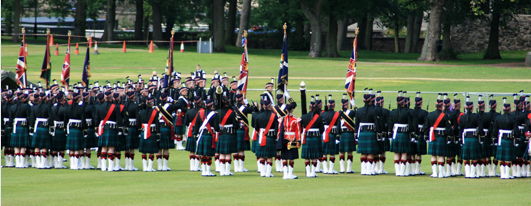As part of her visit to open wur pairliament, this weekend, Queen Elizabeth presented new colours to six of the seven battalions of the Royal Regiment of Scotland (RRS: the 4th Bn is absent, serving in Helmand). Those with little empathy for the military may not appreciate the symbolism and seriousness attached to poles with flags hanging off. But when you are asking young men to lay their lives on the line, military discipline is all the more effective if honed by ideals, self-belief and a little shared symbolism.
The former regiments each had their own pair of colours—a Queen’s colour, which held battle honours from two world wars and a Regimental colour, carrying battle honours from a myriad of campaigns from the 17th century to Iraq. Anyone visiting les Invalides in Paris will be struck by the serried rows of ragged regimental colours with similar battle honours, all gathered together in peace at last. Originally carried ahead into battle, colours would be defended to the death: losing them was disgrace.
But, being a single regiment now, all the honours accumulated by all the infantry regiments of what could be regarded as the Scottish Army had to be squeezed onto two flags—an impossible task. The Queen’s colour carries 32 honours (arbitrarily chosen as common to two or more of the battalions). The Regimental colour carries the maximum 46 of the 339 honours to which they were entitled. What horse trading decided which remains unknown. But the real tragedy is that five active ‘regiments’ that became component battalions were themselves the result of many amalgamations. Names of famous regiments, not to mention deeds, lie buried under re-organisation.
Those with little military interest may skip this paragraph but others interested in the scale of amalgamation, read on. The Argylls (5th Bn RRS) came from merging the 91st and 93rd Highlanders: the 71st (Fraser) and 74th (McLeod) Highlanders amalgamated to form the Highland Light Infantry which combined with 21st (Royal Scots Fusiliers) to form the Royal Highland Fusiliers (2nd Bn RRS); the 75th and 92nd became the Gordons and, together with 72nd and 78th, who formed the Seaforths, merged with the Queen’s Own Cameron Highlanders to form the Highlanders (4th Bn RRS); the Black Watch (in Gaelic Am Freiceadan Dubh, 3rd Bn RRS), started as guard companies along the Highland line and reformed from the 42nd and 73rd; these four remaining Highland regiments amalgamated with the merged lowland Royal Scots and Royal Scottish Borderers (1st Bn RRS) to form the Royal Regiment in 2006. The 51st Highland (7th Bn RRS) and 52nd Lowland (6th Bn RRS) are Territorial (i.e. reserve) battalions. Others were already history; the Cameronians started as Covenanters with muskets, became the 26th Foot, absorbed the 90th Perthshire Light Infantry to disband in 1967; eight yeomanry regiments were disbanded post-WW2.
A number of other Scottish units, such as the Scots Guards, do still exist. But the core of any pretence at a ‘Scottish Army’ is the infantry. Even though we no longer aspire to empire, the scale of reduction is massive and the extent to which dogged courage, occasional brilliance and fearsome reputations have drifted from common knowledge is deplorable. Even allowing for huge declines in Highland populations, Scottish infantry has suffered disproportionate disbandment. Over three hundred years, the British Army earned an enviable reputation for professional soldiering, among which the ‘Ladies from Hell’ figured prominently and enthusiastically. Whether the same fierce pride and tough resolution that built their reputation can be maintained as a single regiment in a declining UK defence force is a question still with no answer.

